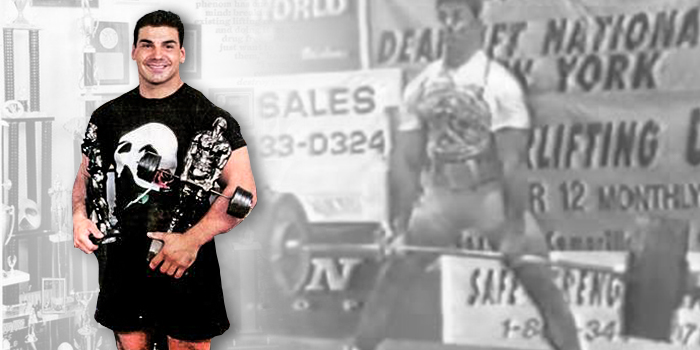
One of the concerns I have with respect to newer lifters based upon comments I read on social media sites and forums is that there seems to be a lack of historical powerlifting knowledge and awareness on the part of today’s younger lifters. I was taught by old-timers that in order to become a complete powerlifter and expand the size of the training toolbox, it was of great value to study the training methods of past lifters. Lifters such as Paul Anderson, Doug Hepburn, Hugh Cassidy, Doug Furnas, Paul Wrenn, Lee Moran, John Kuc, Don Reinhoudt, Bill Kazmaier, Larry Pacifico, Mike Bridges and countless others paved the way with training techniques that, though seemed simplistic, were in fact quite sophisticated. Modern scientific investigation is beginning to prove that John Kuc’s high-frequency back work, Doug Hepburn’s potentiation programs, Mike Bridges’ minimalist approach, Bill Kazmaier’ high volume power-building, and Paul Anderson’s pioneering of partials are all valid training methods. We must not forget that today’s programming, such as Westside, Juggernaut, Starting Strength, RPE, etc., all have their foundations in these past systems.
RECENT: My Powerlifting Influences
Today I present a training technique of a lifter who is not well known by many youngsters today. Steve Scialpi was a powerlifter from Queens, New York who was active in the ADFPA and WNPF in the early to mid-90s. Steve began lifting as a teenager and competed in several local bodybuilding contests. He soon discovered that his real gift was strength and converted to powerlifting. He had unorthodox lower body training methods due to his injury history. He was hit by a construction vehicle on one of his father’s construction sites and as a result suffered a pelvic fracture and developed a chronic sciatic nerve problem. This condition prevented him from squatting very much and also precluded heavy deadlifting with any frequency or regularity. His solution was to train the squat using a Tru Squat machine and the 45-degree leg press, and to train the deadlift with light weight and high volume. As a result, watching him walk out and set up to squat was truly scary — he looked like a stalk of wheat in a breeze until he was locked in. His deadlift, however, was a completely different story. Steve eventually built his deadlift up to an official 800 pounds in the 198-pound weight class. At that time only Coan, Thomas, and Anello had bested the 800-pound barrier in the 198-pound weight class.
His sumo technique was unorthodox also. He would be wide with the toes an inch from the plates, the hips as high as possible — only low enough for the fingers to grip the bar. He would descend with a tight back arch until the fingertips were touching the bar without looking down. Then, using some stretch reflex, he would dip, grip, and pull slowly until breaking the floor, then complete the lift. He carried the bar low in the fingertips and also allowed the scapulae to protract hard, lessening the pulling distance. He called his technique “the illusion of great genetics.”
The Program
The program is designed around the wide stance sumo deadlift. The program is 12 weeks long with no deadlifting the week of the meet. The first eight weeks you will load 35-pound plates on the bar or use a 1.5-inch deficit and train with no belt. The starting weight is 50%. When performing the reps the bar does not touch the ground. You lower the bar until the plates hover just above the floor, then pull up and continue doing reps in this manner maintaining continuous tension. The last four weeks you will use the full diameter 45-pound plates and wear all your meet gear (belt singlet or suit, slippers or deadlift shoes). All reps during these four weeks will be performed using competitive technique.
The program breaks down as follows, calculated for a 500-pound deadlifter.
- Week 1: 250, 2 x AMRAP
- Week 2: 260, 2 x AMRAP
- Week 3: 270, 2 x AMRAP
- Week 4: 280, 2 x AMRAP
- Week 5: 290, 2 x AMRAP
- Week 6: 300, 2 x AMRAP
- Week 7: 310, 2 x AMRAP
- Week 8: 320, 2 x AMRAP
- Week 9: 400 (80%), 5 x 3
- Week 10: 425 (85%), 3-5 x 3
- Week 11: 450 (90%), 3-5 x 2
- Week 12: 475 (95%), 2-3 x 2
- Week 13: Rest
- Meet Day: 475, 500, 520-530
- Assistance Work: 4-6 sets of pulldowns or chins, ab work
I ran this in '94 and got about 100 pounds in three cycles. I caution any of you who try this to put the squat and bench on maintenance because the volume is brutal. This is not for beginners and not for older master lifters. This is old school stuff when there was no such thing as overtraining and deloading. The first week I ran this I was a 450-pound deadlifter and did 225 for two sets of 40 and 30 reps, respectively. Proceed with caution.
The first time you read a program such as this your impulse is to dismiss it outright, thinking its impossible to get strong with so many deadlift reps. However, on closer examination, it seems more sensible when lower back physiology is accounted for. The spinal-supporting muscles are intended to work isometrically during a deadlift, so it makes sense to train them using a time under tension protocol. Of course, you can’t train this type of lower back volume frequently, because the limited blood supply to the lower back causes a long recovery period between deadlift sessions. Another thing to consider is that construction workers tend to have very strong backs despite never having deadlifted. Their backs became strong by performing a very high volume of submaximal lifts day in and day out.
Obviously, this program is not for all lifters, but you don’t know what you’re capable of until you try. If you are a sumo deadlifter and you’re stuck at a plateau, give this method a try. You might be pleasantly surprised. Just don’t say I didn’t warn you. Good luck.











1 Comment